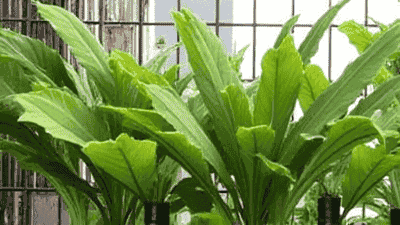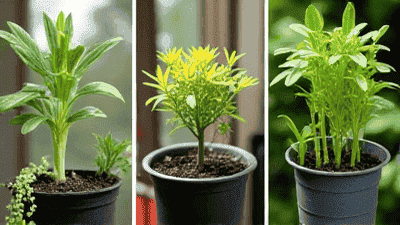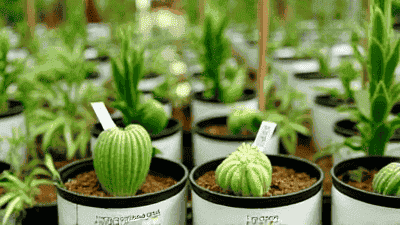Recommended herbaceous plants suitable for indoor cultivation
Indoor gardening is a fulfilling hobby that can improve air quality, enhance the aesthetic of your living space, and provide fresh herbs and plants for culinary use. Herbaceous plants, known for their soft, green stems and diverse varieties, are particularly well-suited for indoor culture.

Understanding Herbaceous Plants
Herbaceous plants are non-woody plants that die back to the ground after each growing season, making them distinct from woody plants like shrubs and trees. They can be perennial, annual, or biennial and typically have flexible stems that are lush and green. Common examples of herbaceous plants include herbs, flowers, and leafy greens.
Benefits of Growing Herbaceous Plants Indoors
Air Quality Improvement: Many herbaceous plants are known to purify indoor air by absorbing toxins and releasing oxygen.
Aesthetic Appeal: Herbaceous plants add vibrant colors and textures to your indoor environment, which can enhance the overall ambiance.
Edible Options: Growing herbs indoors allows for fresh access to culinary ingredients, enhancing your cooking and promoting healthy eating.
Therapeutic Effects: Indoor gardening can reduce stress and improve mental well-being, as nurturing plants encourages mindfulness and relaxation.
Selecting the Right Herbaceous Plants

When choosing herbaceous plants for indoor culture, consider factors such as light availability, humidity levels, and your personal preferences regarding maintenance and usage. Below, we will discuss some recommended herbaceous plants suitable for indoor gardening, along with their care requirements and benefits.
1. Basil (Ocimum basilicum)
Basil is a popular culinary herb known for its aromatic leaves that enhance a variety of dishes, particularly in Mediterranean cuisine. It is easy to grow indoors and thrives in bright light.
Care Requirements
- Light: Basil requires at least six hours of direct sunlight daily. If natural light is limited, consider using a grow light.
- Watering: Keep the soil consistently moist but not waterlogged. Water when the top inch of soil feels dry to the touch.
- Soil: Use well-draining potting mix enriched with organic matter.
- Temperature: Basil prefers warm temperatures ranging from 70 to 85 degrees Fahrenheit (21 to 29 degrees Celsius).
Benefits
- Culinary Uses: Fresh basil adds flavor to salads, pastas, pizzas, and sauces.
- Health Benefits: Basil contains antioxidants and has anti-inflammatory properties.
2. Mint (Mentha spp.)

Mint is a highly versatile herb famous for its refreshing flavor and aroma. It is easy to grow indoors and can be used in various culinary applications, beverages, and teas.
Care Requirements
- Light: Mint prefers bright light but can tolerate partial shade. Aim for four to six hours of sunlight each day.
- Watering: Keep the soil consistently moist, as mint thrives in humid conditions. Ensure good drainage to prevent root rot.
- Soil: Use a rich, well-draining potting mix.
- Temperature: Mint prefers temperatures between 65 and 70 degrees Fahrenheit (18 to 21 degrees Celsius).
Benefits
- Culinary Uses: Mint enhances dishes like salads, desserts, and cocktails.
- Health Benefits: Mint can aid digestion and provide respiratory relief.
3. Chives (Allium schoenoprasum)
Chives are a hardy herb with a mild onion flavor. They are easy to grow indoors and can be harvested year-round.
Care Requirements
- Light: Chives require at least six hours of bright light daily; a sunny windowsill works well.
- Watering: Water when the top inch of soil feels dry. Chives prefer slightly moist soil, but avoid waterlogging.
- Soil: Use a standard potting mix that drains well.
- Temperature: Chives thrive in temperatures of 60 to 70 degrees Fahrenheit (15 to 21 degrees Celsius).
Benefits
- Culinary Uses: Chives can be used as a garnish or added to salads, soups, and sauces for a mild flavor.
- Health Benefits: Chives are rich in vitamins A and C and may support heart health.
4. Parsley (Petroselinum crispum)

Parsley is a popular culinary herb known for its fresh flavor and versatility. It can be grown indoors successfully with the right care.
Care Requirements
- Light: Parsley requires at least four to six hours of sunlight daily. A windowsill with indirect sunlight is ideal.
- Watering: Water the plant when the surface soil feels dry. Ensure that the pot has drainage holes.
- Soil: Use a well-draining potting mix rich in organic matter.
- Temperature: Parsley does well in temperatures between 70 and 75 degrees Fahrenheit (21 to 24 degrees Celsius).
Benefits
- Culinary Uses: Parsley adds flavor to various dishes and enhances the presentation of meals.
- Health Benefits: Parsley is rich in vitamins K, C, and A, as well as antioxidants.
5. Cilantro (Coriandrum sativum)
Cilantro, also known as coriander, is a popular herb used in various cuisines, particularly in Latin and Asian dishes. It’s known for its unique flavor and aroma.
Care Requirements
- Light: Cilantro prefers full sun, requiring about six hours of direct sunlight daily.
- Watering: Keep the soil consistently moist, but do not let it become waterlogged. Water when the top inch of soil is dry.
- Soil: Use well-draining potting soil with organic material.
- Temperature: Cilantro thrives in cooler temperatures, ideally between 65 and 75 degrees Fahrenheit (18 to 24 degrees Celsius).
Benefits
- Culinary Uses: Cilantro is commonly used in salsas, salads, and as a garnish for various dishes.
- Health Benefits: Cilantro has antimicrobial properties and may help lower anxiety.
6. Oregano (Origanum vulgare)
Oregano is a staple herb in Italian and Mediterranean cooking, known for its robust flavor. It is well-suited for indoor growing, making it an ideal herbaceous choice.
Care Requirements
- Light: Oregano thrives in full sun, requiring at least six hours of direct sunlight per day.
- Watering: Allow the soil to dry slightly between waterings. Overwatering can lead to root rot.
- Soil: Use a well-draining potting mix, as oregano prefers drier conditions.
- Temperature: Oregano prefers warm conditions, ideally between 70 and 80 degrees Fahrenheit (21 to 27 degrees Celsius).
Benefits
- Culinary Uses: Oregano enhances pizzas, pasta dishes, and Mediterranean recipes.
- Health Benefits: Oregano is rich in antioxidants and has antibacterial properties.
7. Thyme (Thymus vulgaris)
Thyme is a fragrant herb commonly used in cooking, particularly in Mediterranean cuisine. It is drought-tolerant and thrives indoors.
Care Requirements
- Light: Thyme requires about six to eight hours of sunlight daily. A south-facing window is ideal.
- Watering: Allow the soil to dry out between waterings. Thyme prefers slightly dry conditions.
- Soil: Use a sandy, well-draining potting mix.
- Temperature: Thyme thrives in temperatures between 65 and 75 degrees Fahrenheit (18 to 24 degrees Celsius).
Benefits
- Culinary Uses: Thyme is used in soups, sauces, and as seasoning for meats and vegetables.
- Health Benefits: Thyme has antimicrobial properties and may support respiratory health.
8. Rosemary (Salvia rosmarinus)
Rosemary is a fragrant herb often used in culinary dishes. With proper care, it can grow successfully indoors and thrive in sunny spaces.
Care Requirements
- Light: Rosemary requires full sunlight, ideally at least six to eight hours daily.
- Watering: Allow the soil to dry between waterings, as rosemary prefers drier conditions. Water thoroughly, but ensure good drainage.
- Soil: Use a well-draining potting mix, ideally with added sand or gravel for improved drainage.
- Temperature: Rosemary prefers warm temperatures around 70 to 75 degrees Fahrenheit (21 to 24 degrees Celsius).
Benefits
- Culinary Uses: Rosemary enhances roasted meats, potatoes, and bread dishes.
- Health Benefits: Rosemary is believed to improve memory and concentration.
9. Sage (Salvia officinalis)
Sage is an aromatic herb known for its earthy flavor. It is easy to grow indoors and complements various savory dishes.
Care Requirements
- Light: Sage requires full sunlight, needing about six to eight hours of direct light each day.
- Watering: Water when the top inch of the soil feels dry. Sage prefers drier conditions and does not tolerate overwatering.
- Soil: Use a well-draining potting mix, with added sand or perlite for aeration.
- Temperature: Sage thrives in temperatures between 65 and 75 degrees Fahrenheit (18 to 24 degrees Celsius).
Benefits
- Culinary Uses: Sage is often used in stuffing, sauces, and roasted meats.
- Health Benefits: Sage has anti-inflammatory properties and may support cognitive function.
10. Lavender (Lavandula spp.)
Lavender is a fragrant herb known for its beautiful flowers and calming scent. It can be grown indoors and is well-suited for sunny spots.
Care Requirements
- Light: Lavender needs full sunlight, so provide at least six hours of direct sunlight daily.
- Watering: Allow the soil to dry out between waterings, as lavender prefers drier conditions.
- Soil: Use a well-draining potting mix combined with sand or gravel to promote drainage.
- Temperature: Lavender thrives in warm temperatures around 70 to 80 degrees Fahrenheit (21 to 27 degrees Celsius).
Benefits
- Culinary Uses: Lavender can be used to flavor desserts, teas, and savory dishes.
- Health Benefits: Lavender is often used for its calming properties and may help relieve anxiety and improve sleep quality.
Care Tips for Indoor Herbaceous Plants
Watering: Understand the specific watering needs for each herbaceous plant. Overwatering is a common issue that can lead to root rot. Always check the soil's moisture level before watering.
Fertilization: Herbaceous plants benefit from regular fertilization during the growing season. Use a balanced fertilizer every four to six weeks, but avoid over-fertilizing, as this can hinder growth.
Pruning: Regularly prune your plants to promote bushy growth and prevent them from becoming leggy. Pinch off the tips to encourage branching.
Pests and Diseases: Inspect your plants frequently for signs of pests such as aphids, spider mites, and whiteflies. Use organic insecticidal soap or neem oil for treatment, and ensure proper ventilation to prevent mold and mildew.
Humidity: Many herbaceous plants thrive in higher humidity levels. If your indoor environment is dry, consider using a humidifier or placing a pebble tray with water beneath the pots to increase humidity.
Container Choice: Use containers with drainage holes to prevent water from accumulating at the bottom. This is especially important for herbs that prefer well-draining soil.
Conclusion
Growing herbaceous plants indoors offers numerous benefits, from enhancing your culinary experiences to improving air quality and your overall well-being. With a diverse range of options available, you can select plants that suit your taste, growing conditions, and maintenance preferences. Whether you opt for fragrant herbs like basil and mint or culinary staples like parsley and chives, each herbaceous plant adds beauty and utility to your home.
By following the care tips provided, you can create a thriving indoor herb garden sure to enhance your cooking and enrich your life.
